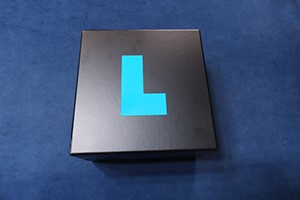
Project L is a board game I found out about initially from fellow Meeple Phil a couple years ago. He touted it as a lightweight engine building puzzle game, and I have to admit, what he showed off was very appealing to me.
One of my favorite elementary school activities was playing with different types of tangrams (small shaped pieces meant to be put together in specific ways to make larger shapes), and anyone who’s watched me play board games knows I love a good engine builder, so I bought the Master Box during Boardcubator’s 2023 Kickstarter.
It sat on my shelf for a few months, awaiting a time where I could sit down and learn how to play it. Then this month, as we were discussing what games would stream well with 3 people since our 4th was going to be travelling the U.S., Phil brought it up again, and I jumped at the opportunity.
And believe me, I was NOT disappointed! Check out our gameplay below, or come back to it after reading the upcoming rulebook and strategy guide!
How To Play Project L
Player Count: 1-5 (1-6 with the Ghost Piece or Phoenix expansion)
Estimated Play Time: 20-40 minutes
Project L Rules PDF
Before going into the setup of the game, I want to talk briefly about each of Project L’s expansions. If you have the Master Box like me, you’ll find yourself playing with several of them right off the bat thanks to the excellent way the Master Box is organized.
Rules for all expansions are also included in the latest version of the Project L rulebook linked above. If you’re just playing the base game, feel free to skip ahead to the Setup section.
Project L Expansions
Ghost Piece
This expansion adds a 5th tier to the available tiles, known as Ghost Pieces. You can earn theses by completing a puzzle with an upgrade reward (denoted by 1 or more red arrows pointing upward) and using one of your level 4 pieces to upgrade to a Ghost Piece.
Note: This is the ONLY way to upgrade a level 4 piece to a level 5 Ghost Piece.

The other way you can collect Ghost Pieces is as a reward for completing specific puzzles, the same way you would for collecting any other piece this way.

Finally, this expansion permits you to add a 6th player if you do not already have the Phoenix expansion.
Phoenix
This expansion adds bigger, more complex puzzles for your Black puzzle deck, which can also award you up to 6 points instead of the previous cap of 5. You may also use this expansion to allow up to 6 players to play if you do not already have the Ghost Piece expansion.
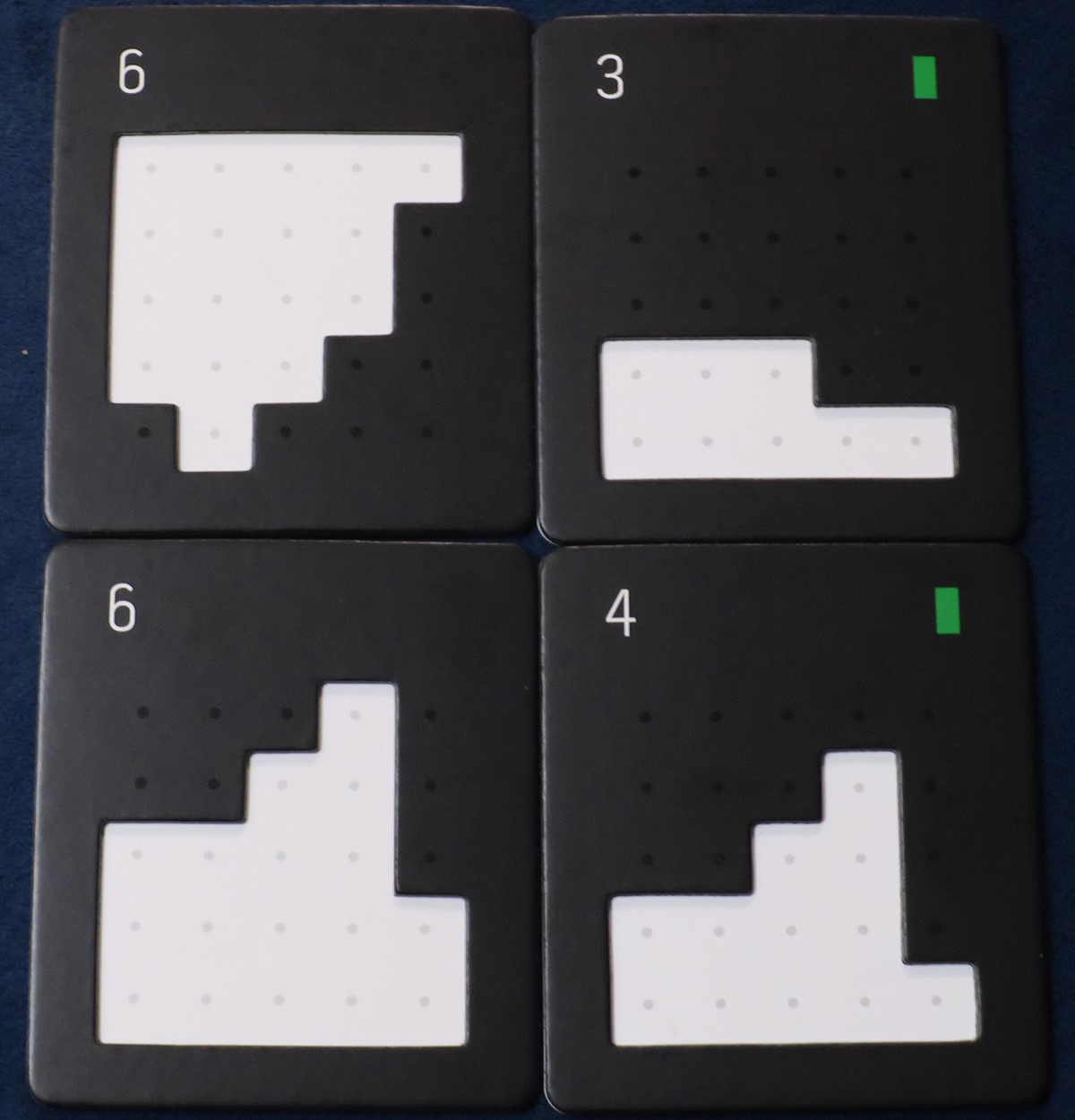
Ambassador
The 2 black puzzles and 1 white puzzle included in this mini-expansion reward their completion with the ability to perform a Master action that does not count against your limit of 1 Master action per turn on a future turn.
You’ll want to snag these ASAP if they turn up during gameplay, and can identify them by the green circle with an M in the upper right corner!
Finesse
The Finesse expansion introduces specific goals to the 3rd through 10th rounds of gameplay. Completing a goal rewards you with a Credit, which may be spent on a future turn. These can be used a couple different ways and as many times as you have the appropriate number of active credits:
- Spending 2 Credits on your turn allows you to take an extra action that doesn’t count against your normal 3 per turn. All other game rules still apply though (so Master Actions may still only be taken once per turn).
- Spending 1 Credit at the end of the game allows you to apply a Finishing Touch without losing a point.
Pink Finesse tiles may be completed any number of times per player each round, and Blue Finesse tiles are checked at the end of the round. Don’t try to hoard the credits either – if someone earns one when the bank is empty and you have the most, you have to give that player one from your own stash!
Fortunately, the Credit bank has 35 Credits, so it should take a while in most games to empty it.
Finesse tiles are grouped into 3 different sets:
- Set A: Only composed of Pink tiles. Place one of the depicted pieces into one of your puzzles and gain 1 Credit for each.
- Set B: Only composed of Blue tiles. Gain 1 Credit for each of the depicted pieces in your supply or within your puzzles at the end of the round.
- Set C: Made up of Pink and Blue tiles. Contains more advanced variations of what is present in the Set A and Set B tiles.
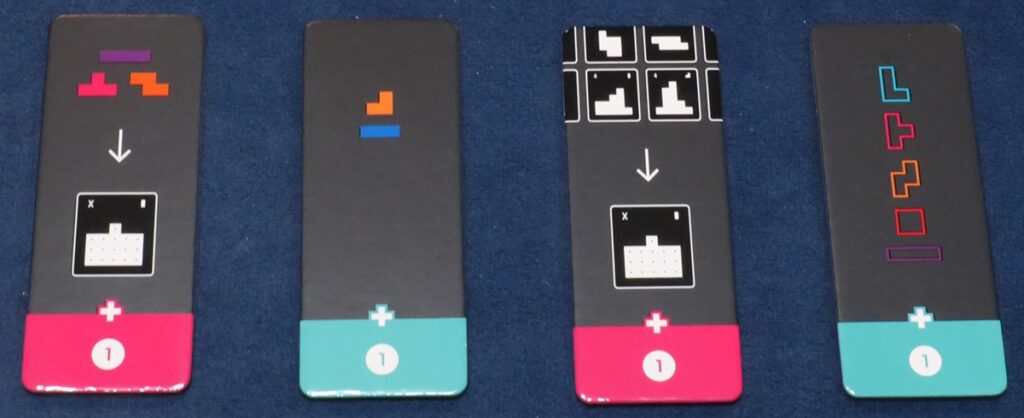
Games also are forced to an end at the end of Round 10 if the black puzzle deck has not been emptied by then.
Finesse Ambassador
The Finesse Ambassador mini-expansion includes 10 new Finesse tiles with additional mechanics for the Finesse expansion. The 2 new tiles for Set A and Set B will work similarly to the Finesse expansion’s counterparts, while the 6 Set C tiles introduce additional advanced goals like those you’d find in other Set C tiles.
Project L Setup

Based on the way Project L’s expansions work, the big decision at the start of the game is whether you are playing with the Finesse expansions.
The Ghost Piece, Phoenix, and Ambassador expansions simply add more variety to Project L’s base gameplay without messing with the rules too much, so I’d say if you have them, assume you’re playing with them at all times unless your group really dislikes one or more of them.
This is especially true with the Master Box, as the Finesse expansions have their own pink tray, but everything else is pretty well combined into the provided blue trays. Those of us playing for our first time didn’t find playing with these 3 expansions at all overwhelming and honestly appreciated their extra variety.
To begin setting up Project L, shuffle your white puzzle cards into a deck, then randomly select a number of black puzzle cards for their own deck based on the number of players:
- 2 Players: 12 Black puzzle cards
- 3 Players: 14 Black puzzle cards
- 4 Players: 16 Black puzzle cards
- 5 Players: 20 Black puzzle cards
- 6 Players: 24 Black puzzle cards
Give each player a Level 1 Yellow piece and a Level 2 Green Piece. Reveal the top 4 cards of each deck and place them to the right of their respective decks. Set the trays of Tetris pieces nearby so they are easily accessible.
If you aren’t playing with the Finesse expansions, you are set up and ready to play!
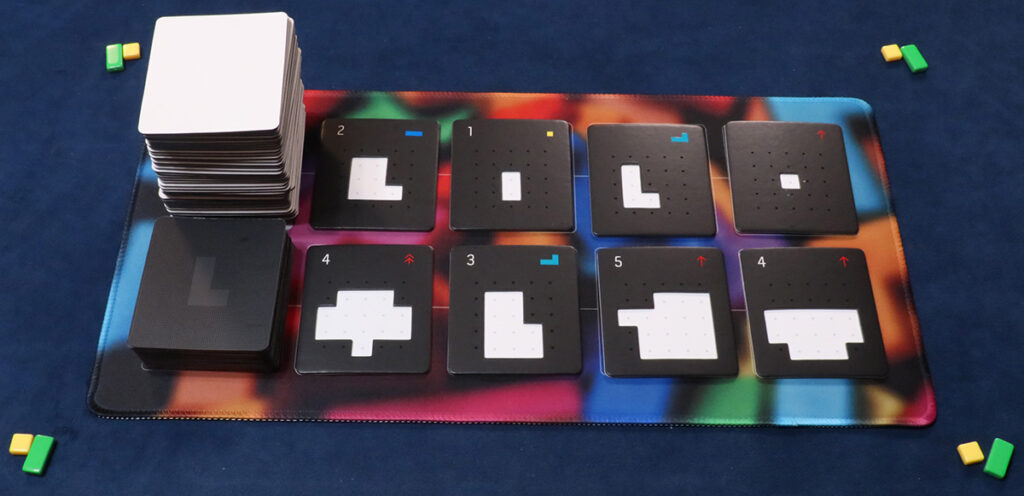
If you are playing with the Finesse Expansions, separate the Finesse tiles into their respective sets (A, B, and C), take 2 tiles from the A deck, 2 from the B deck, and 6 from the C desk. Shuffle them, then place the first two tiles face down under your White and Black puzzle rows, starting on the left side.
The remaining 8 are dealt face up to the right of your face down Finesse tiles. These represent the goals you are trying to complete during the 3rd – 10th rounds of the game. No Finesse goals are available during the first 2 rounds of gameplay, which is why those are displayed face down.
Set the Finesse Credits aside to form the Credit bank, find a way to randomly determine who is going first, and then start the game!
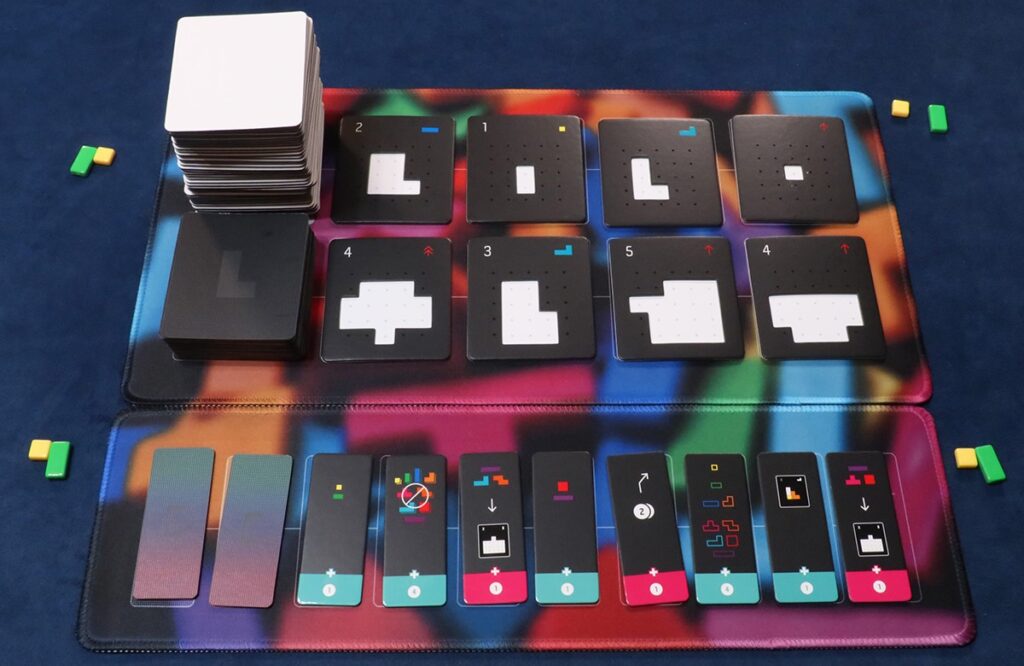
Project L Gameplay
For those who are familiar with games like Ticket to Ride, the way turns work will feel very familiar. There are up to 8 different actions you can take during your turn, each may be taken as many times as you want (exempting the Master action), but you only get 3 actions per turn.
How do you keep track of so many choices? Fortunately, your player mat doubles as a cheatsheet!
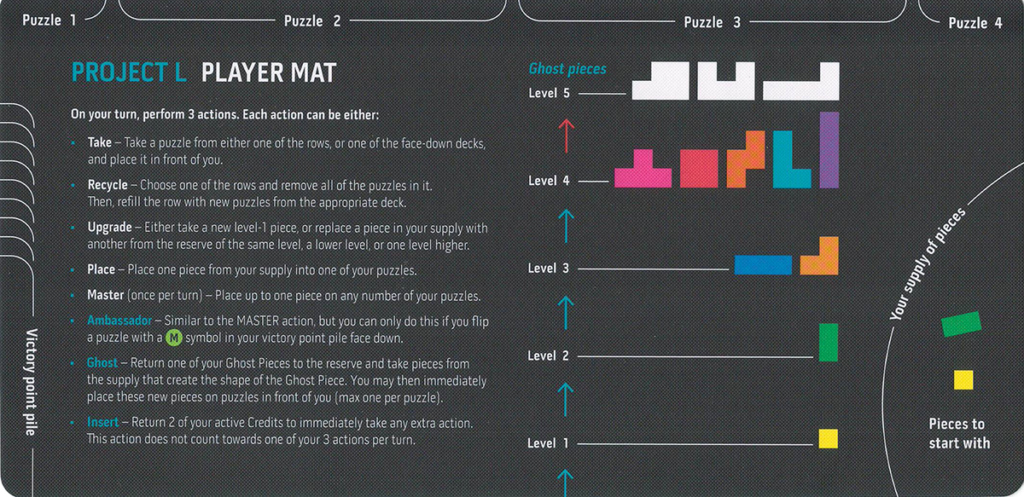
While a decent cheatsheet, the player board doesn’t fully explain the nuances of some of the actions, so I’m going to recap them in more detail as well.
Base Game Actions
- Take: You may not take this action if you already have 4 incomplete puzzles in front of you. You may take one face up white puzzle or black puzzle to place in front of you, or you may draw the top card of either puzzle deck, reveal it, and place it front of you.
- Recycle: Choose the black puzzle deck or the white puzzle deck. Take all revealed puzzles from that row and place them on the bottom of the appropriate deck in an order of your choice. Then reveal the top 4 puzzles of that deck and place them in the empty row.
- Upgrade: You may take a new Level 1 Yellow piece from the reserve. If you do not, return 1 unused piece from your supply and replace it with 1 piece from the reserve that is one level higher, the same level, or a lower level.
- Note: The Upgrade action may NOT be used to upgrade a Level 4 piece to a Ghost Piece. Complete a puzzle that awards one directly or rewards you with a red arrow (or 2) to do this instead.
- Note: If there are no more copies of a piece you can take because of an Upgrade action, you must instead take a different piece you are eligible for – unless you want to take a piece that is a level higher than the one you are returning, but no pieces of that level are left in the reserve. Then you may instead take a piece that is one level higher than the one you were supposed to originally receive.
- For example, if you want to upgrade a Level 2 piece to a Level 3, but there are no Level 3 pieces in the reserve, you may instead take a Level 4 piece. If you want a new Level 1 piece, but no Level 1 or 2 pieces are available, you may take a Level 3 piece.
But if you want an L shaped Level 4 piece while there are still straight line and square Level 4 pieces, you’ll have to either make do with what’s available at Level 4 or take a piece of a lower level.
- For example, if you want to upgrade a Level 2 piece to a Level 3, but there are no Level 3 pieces in the reserve, you may instead take a Level 4 piece. If you want a new Level 1 piece, but no Level 1 or 2 pieces are available, you may take a Level 3 piece.
- Place: Take one of your unused pieces from your supply and lay it flat in the recessed area of 1 of your incomplete puzzles. It may not overlap with an existing piece, be placed diagonally, be moved after it is placed, or be removed after it is placed. It can, however, be rotated in any cardinal direction prior to placement.
- Master: You may only take this action once per turn. Place up to one unused piece from your supply on each of your incomplete puzzles.
Expansion Actions
These actions, denoted in Blue on your player mat, may only be used if you are playing with the appropriate expansion.
- Ambassador (Available in the Ambassador expansion): You may only take this action if you have completed a puzzle with an “M” symbol in the upper right corner on a previous turn and it is still face up. Turn one puzzle with the “M” symbol face down and place it in your Victory point pile, then place up to one unused piece from your supply on each of your incomplete puzzles.
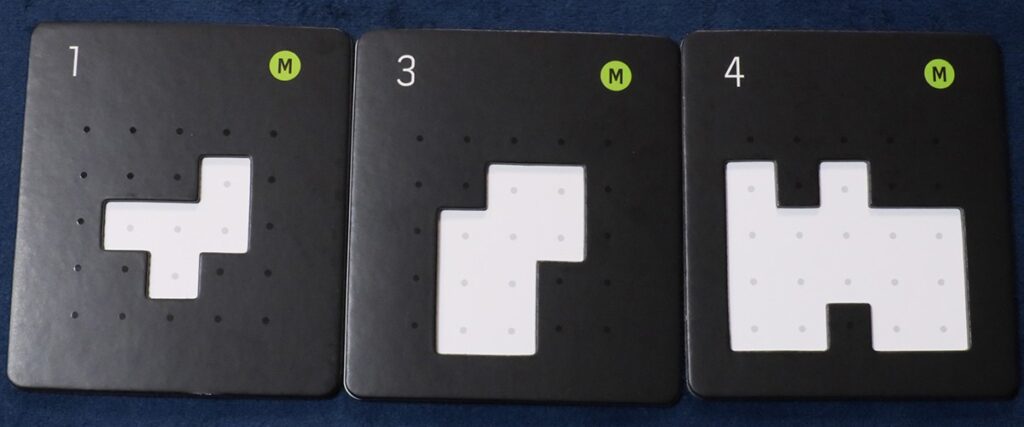
- Ghost (Available in the Ghost Piece expansion): You may only take this action if you have an unused Ghost Piece in your supply. Return 1 Ghost Piece from your supply to the reserve, then take any number of Level 1 – Level 4 pieces from the reserve that can form the shape of the Ghost Piece you returned (5 squares’ worth). Place up to 1 of these new pieces on each of your unfinished puzzles, then add any unused pieces to your supply.
- Insert (Available in the Finesse and Finesse Ambassador expansions): You may only take this action if you have at least 2 active Credits (Credits acquired on a previous turn). Return 2 active Credits to the bank, then immediately take an extra action that does not count against the 3 you receive each turn. All other rules of actions apply (for example, you’re still limited to 1 Master action per turn).
- Note: Yes, this also means that the Insert action itself does not count against your 3 actions per turn.
How To Win Project L
Your goal is to be the player with the most points at the end of the game. To get points, you’ll need to successfully complete puzzles. A completed puzzle’s point value is noted as a white number in the upper left hand corner – if a number isn’t present, the puzzle is worth 0 points.
To complete a puzzle, you need to completely fill its recessed area with any combination of pieces. When you do so, perform the following steps in this order:
- Return all pieces used for that puzzle’s completion to your supply.
- Collect any rewards from your puzzle (found in the upper right corner). Apart from the Ambassador puzzles, these rewards are collected immediately and do not count against your 3 actions per turn.
- Note: If there is no more of a piece you’re supposed to take as a reward, you may instead take a different piece of the same level. If no pieces of that level are available, you may instead take a piece that is one level higher or lower than the one you were supposed to get.
- Place the puzzle face down in your victory point pile – unless its reward is an Ambassador action. In these rare cases, place it face up next to your Victory point pile (you’ll still get the points even if you don’t get to use it). On a future turn, you may flip it face down to take an Ambassador action.
Your turn continues as normal if you have any remaining actions to take afterward.
The end of a Project L game can be triggered a couple different ways. If you are not playing with the Finesse expansions, the end of the game triggers when there are no more cards in the Black puzzle deck.
From this point, players may only take 1 additional Black puzzle per turn (puzzles taken before the end of the game was triggered do not count), the current round finishes, and then one more round is played.
For games that are using the Finesse expansions, the game can end this way or after 10 rounds, whichever comes first.
After the last round, players may perform Finishing Touches. Each Finishing Touch is treated as a Place action, and each costs 1 Victory point when figuring out your score. If you’re playing with the Finesse expansions, you may spend an unused Credit instead of a Victory point for a Finishing Touch.
Pieces are not returned to your supply when completing puzzles this way and rewards are not collected, so you’ll have to work with what’s left in your unused pieces. Incomplete puzzles will also cost you points equal to their point value, so figuring out whether Finishing Touches will save you points is key.
After this, total up the points of all your completed puzzles, then subtract Victory points equal to the total value of your incomplete puzzles + the number of Finishing Touches you made. The player with the most points wins!

In the event of a tie, tiebreakers work in this order:
- (Finesse games only) The player with the most Credits wins.
- The player who completed the most puzzles wins.
- If there is still a tie, the player with the most unused pieces in their supply wins.
- Claim co-victory with all players who tied you.
Project L Strategies
Now that we’ve covered how to play and the objective of Project L, let’s focus on how to end up with the most points and win! While pretty easy to pick up on, Project L has an impressive amount of strategic depth that had me considering options for far longer than I expected.
As I got some games under my belt, however, I found several ways to quickly improve my performance and make my gameplay much more efficient, and now I’m ready to share my discoveries! Master them, and you’ll always be a force to be reckoned with!
Avoid Puzzles That Score 0 Points
This isn’t going to be possible 100% of the time, but in the vast majority of games, this is an easy way to shore up your point total. Sure, the rewards on many of the 0 point puzzles will be very tempting, and you may have to snag one early on to get your engine online.

Despite this, you won’t be scoring any points at the end of the game based on your pieces – you’ll be scoring them from completed puzzles. Actions spent on these are just less effective than those spent on a puzzle worth even 1 point, even if it’s going to be a little harder to complete.
Use The Master Action Whenever Possible
The Master action is worth up to 4 Place actions at once, so setting up to use it every turn should be a top priority throughout the game. Even if you only get to use it with 2 or 3 puzzles, you’re coming out far ahead in action economy, which will win you a lot of games, Project L included.
Sometimes you’ll want the flexibility to snag a puzzle though, so there is some risk involved with going for a 4 puzzle action. In a worst case scenario, you can Recycle some dangerous puzzles in a pinch, but if something good turns up from the Black puzzle deck, it will be very challenging to bury it in the deck for long.
In that same vein, puzzles that reward an Ambassador action should always be a top priority. Giving these to your opponents will put them ahead of you unless it’s the last round or two of the game, so do anything you can to take them for yourself or Recycle them away.
Quickly Build A Supply With Many Different Large Pieces
Black puzzle tiles give far more points than White puzzle tiles, especially with the Phoenix expansion’s 6-pointers in play. Putting yourself in a position to quickly complete these as soon as possible is not only good for your point total, it helps you dictate the flow of the game.
However, these can take as many as 19 squares’ worth of tiles to complete, so you don’t want to be filling them in with 1 square Yellow tiles – you want to be filling them in 4 or 5 squares at a time with Level 4 tiles and Ghost Pieces.
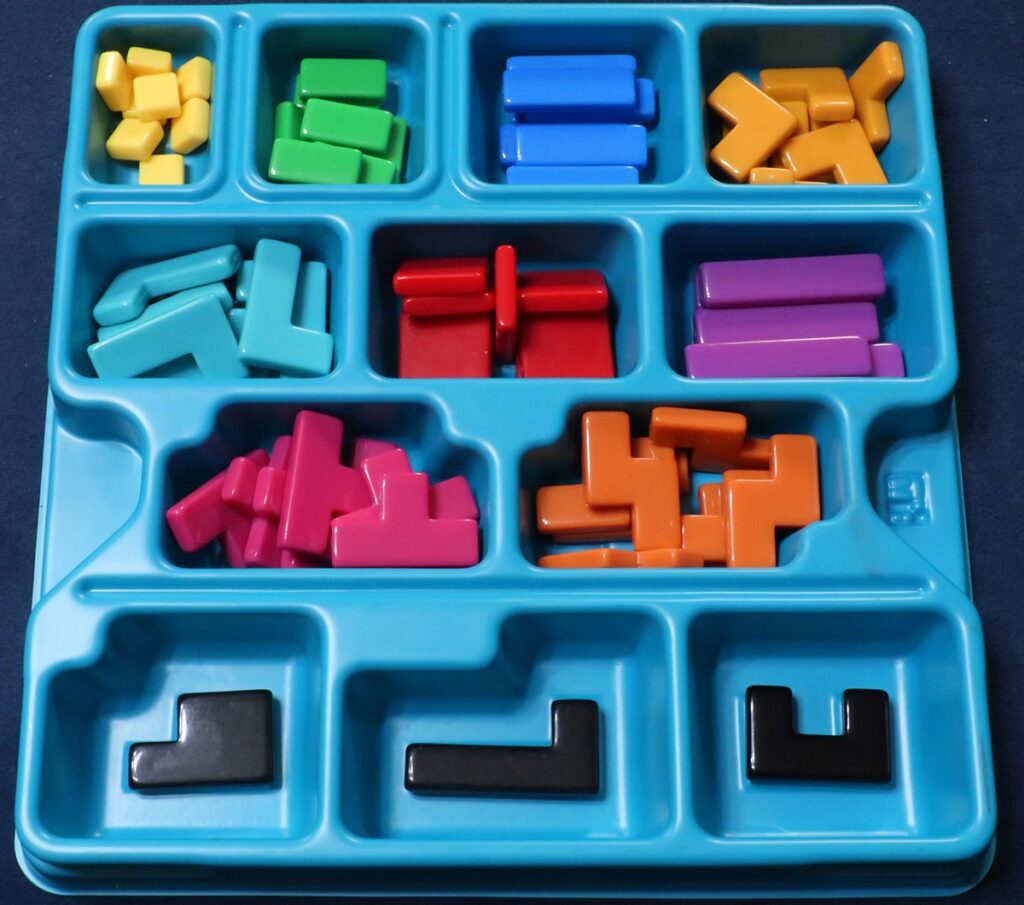
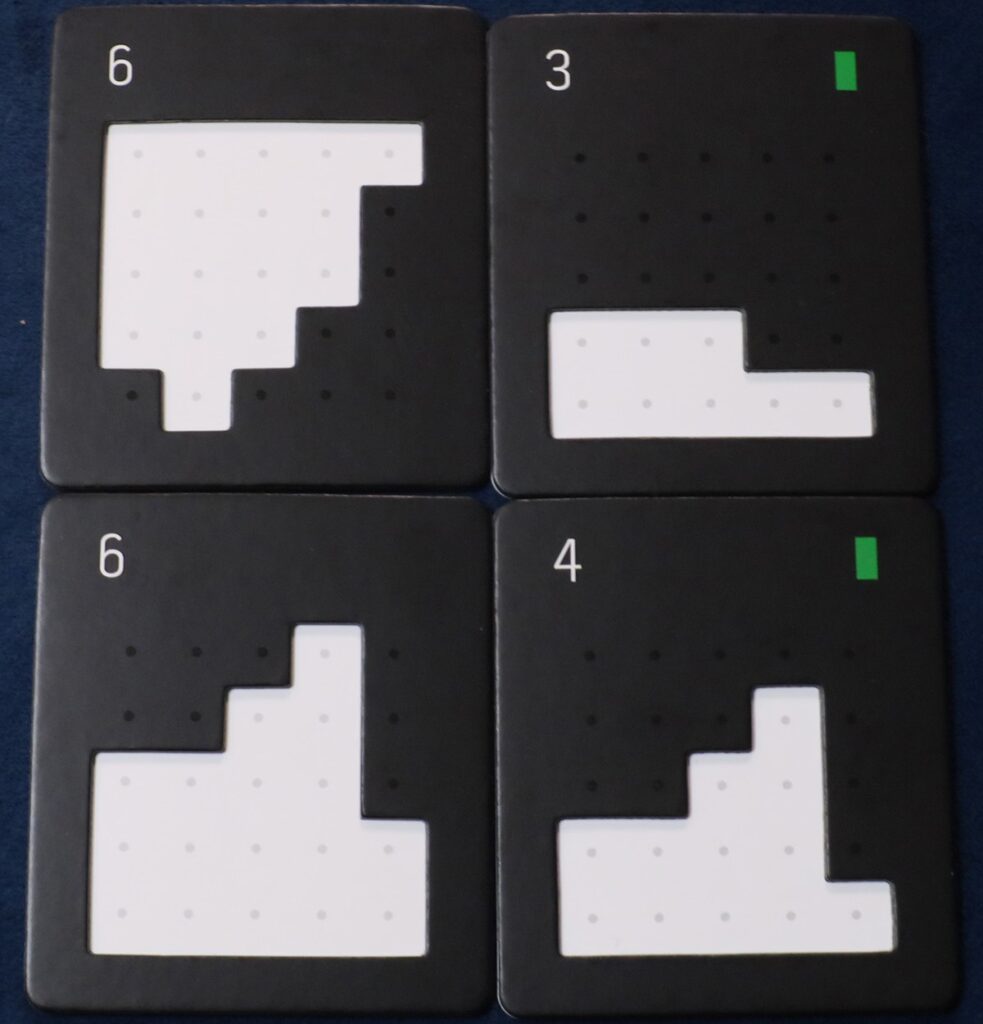
See what I mean? Ghost Pieces can give you an especially big leg up here, so take advantage of them whenever possible.
Resist The Temptation To Break Ghost Pieces
Seriously – this should be a last resort. While the Ghost action looks like a reasonable impression of the Master action, it’s the definition of winning a battle only to lose a war.
The only times I would consider breaking these powerful pieces up is if I needed to work around the reserve being out of a piece to claim a reward or after the end of the game has been triggered. I’m sure there are corner cases beyond this, but they are the exception, and I’ve never seen them come up.
Playing With Finesse? Prioritize Credits!
Credits are literally a gateway to extra actions, and if you recall my earlier lauding of the Master action, tools that improve your action economy are very, very powerful.
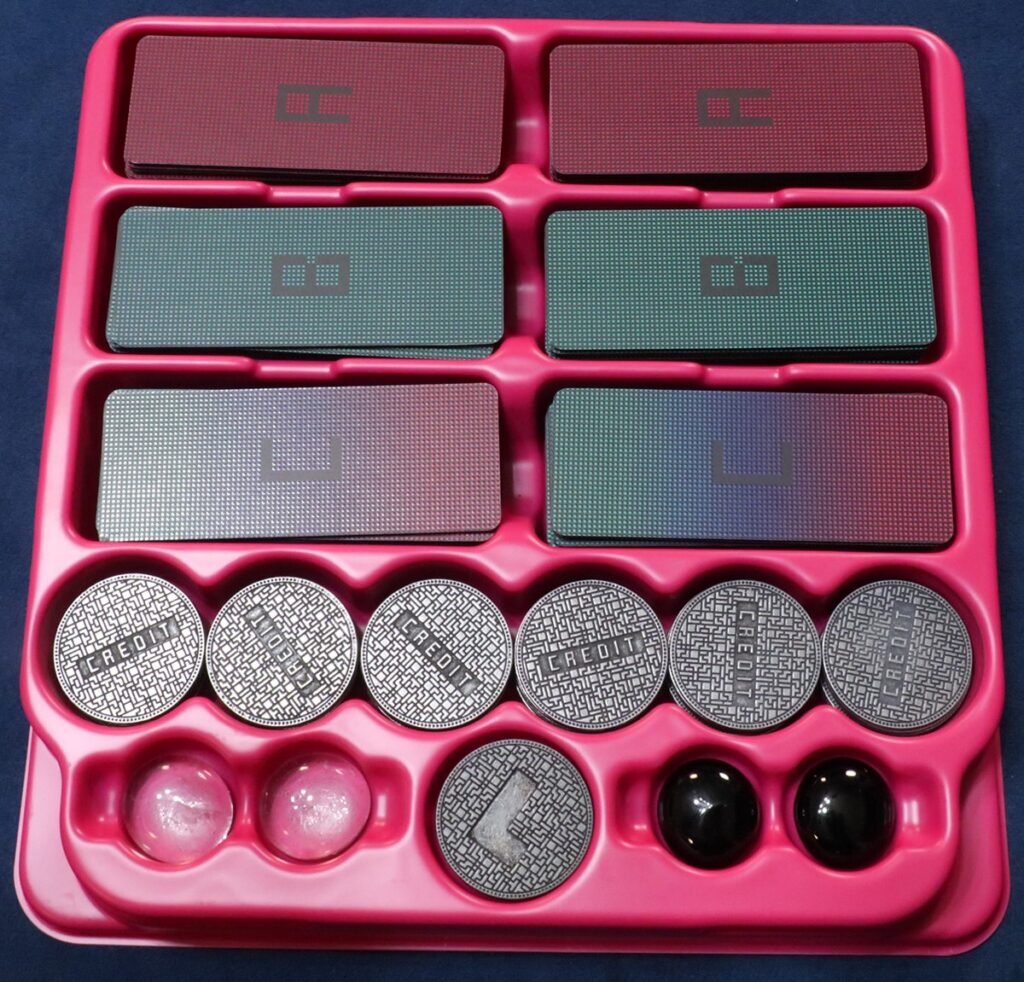
This is also pretty easy to do because you’ll get to see what the Finesse goals are from the very start of the game, so you can work preparation into your first rounds of the game if you put a little extra thought into your game plan.
The only real drawback is that your opponents can do this too, so if even one player at the table takes advantage of this strategy, everyone who isn’t will fall behind VERY quickly.
Pay Attention To The Black Puzzle Deck
Emptying the Black puzzle deck triggers the last rounds of the game, which in turn puts a cap on how long you have to finish up the plans you’ve set in motion.
If there are only a couple tiles left, it’s probably a bad idea to waste time gathering extra pieces for an impressive play 3 rounds out. If there are 6 or 7 left while everyone has a few puzzles to work on, feel free to build your most elaborate scheme.
Squeeze Out A Few Extra Points With Finishing Touches
If it’s the last round of the game, your instinct might be to consider that last Black puzzle tile to be a bad thing to pick up. But what if it’s worth 6 points and you can add a couple tiles to it on your turn, allowing it to be completed with 3 Finishing Touches?
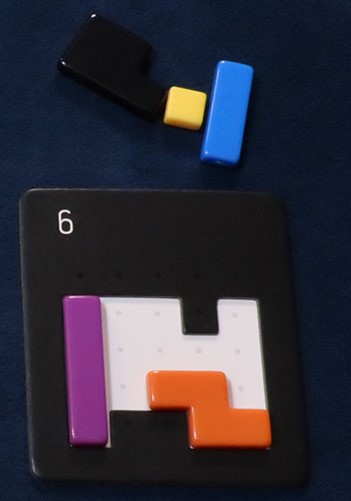
Well, then it’s still worth 3 points! If you have nothing better to do, that seems like a great move in my book. Now, if you have 3 incomplete puzzles that are emptier than you’d like, that might be a different story. Take a moment to evaluate the situation, review your options, and plan accordingly.
Do Not Count On Puzzles Wheeling Back To You Next Turn
The available puzzles change rapidly from both puzzle decks throughout a round, so if you really want a puzzle, you need to include a plan to Take it as part of your turn. Similarly, if a good puzzle is revealed right after your turn, assume someone else is going to snag it before you.
The Recycle Action Sucks
It doesn’t advance your puzzles, upgrade your pieces, or improve your point total in any way. There are times where you really need to use it though, like if an Ambassador puzzle turns up while you already have 4 incomplete puzzles, so sometimes you’ll have to grit your teeth and do it anyway, but it should always be a last resort.
It’s also pretty ineffective on the Black puzzle deck outside the early turns of the game, since the deck is just so small. You might be able to manipulate the knowledge of your order placement to pull some big brain shenanigans in end game, but even then, it still feels like a wasted move.
Project L Variants
Feel like you’ve mastered everything Project L has to offer now that you’ve gotten a few dozen games under your belt? Think again – Project L has a few variants that will change up gameplay either subtly or dramatically, along with an entirely new game to explore!
Line Clear
This is the intended game mode for 5 or 6 players. Setup is very similar to the normal version of gameplay, but you’ll instead have two rows of White and Black puzzle tiles placed on either side of their respective decks.
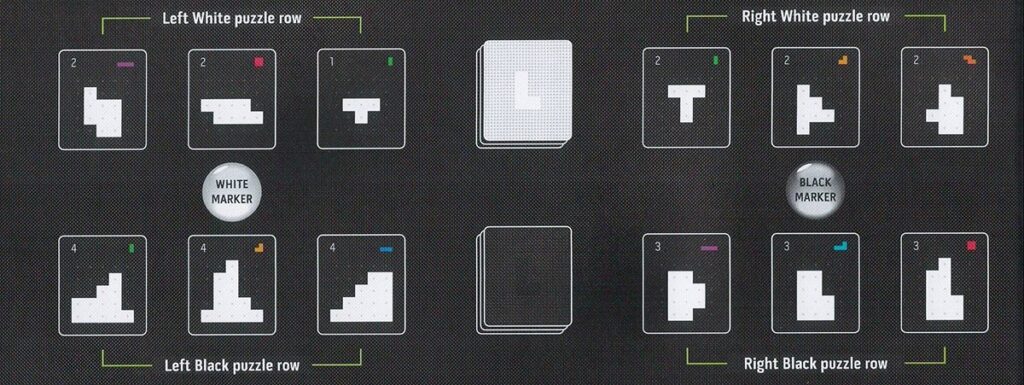
As you can see, these are divided into a left (white) side and a right (black) side, which are denoted by special pairs of markers. The first white and black markers are placed between the white and black puzzle rows on each side, as shown in the picture.
Give the second White marker to the 1st player, and the 2nd Black marker to the 3rd player in a 5-person game, or the 4th player in a 6-person game. This will allow two players to take their turns simultaneously, and each action must be decided simultaneously within those turns.
When it is your turn, you can only take puzzle cards from the rows that match your marker’s color (So if you have the white marker, you can only take face up White and Black puzzles from the left side of the board).
Further, only the player with the White marker may Take puzzle cards from the top of the deck, and they’re the only one allowed to use the Recycle action – but only on the left rows. This means you cannot Recycle the right rows at all.
Did I mention the Recycle action sucks?
The end of the game triggers as normal, and the game ends when the first player has been passed both markers. As soon as they are passed the second marker, regardless of the order they were passed, the game ends, and scoring is tallied like a regular game of Project L.
If you are playing with the Finesse expansion, the end of a round triggers when the 1st player is passed the white marker.
Solo Play
This is one of two gameplay variants of Project L you can play by yourself, and is designed for play without the Finesse expansions. Setup begins by selecting 15 random White puzzle tiles and 10 random Black puzzle tiles. Shuffle each puzzle deck separately, then place the Black one in the center of the table and the White one on top of it.
Reveal the top 9 cards of the puzzle deck and arrange them in a 3×3 grid, then place one random piece above the first column, 2 above the 2nd, and 1 above the 3rd. Give yourself a Level 1 piece and a Level 2 piece. Columns with at least 1 piece above them are considered locked.
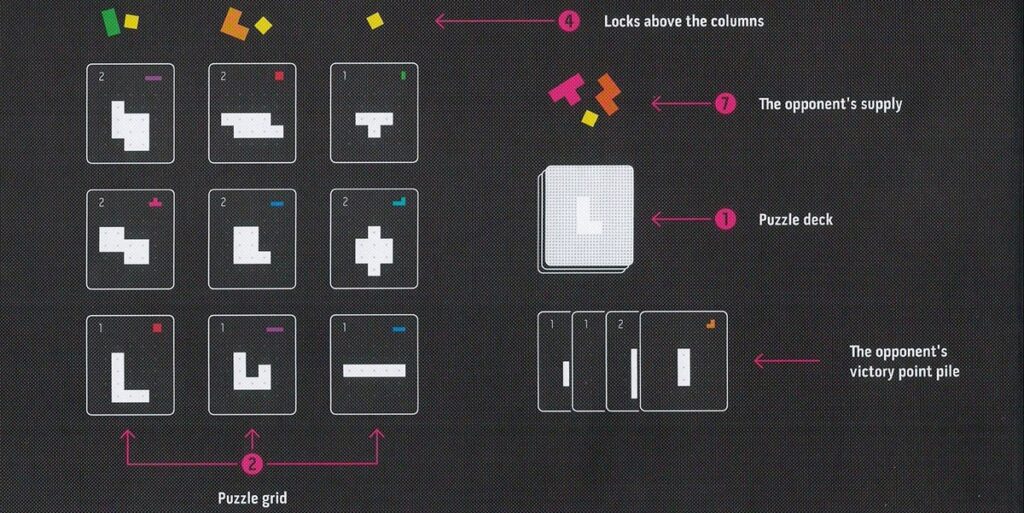
You then decide how many pieces to give your opponent. There are 3 difficulty levels:
- Normal: Give your opponent 6 pieces
- Hard: Give your opponent 3 pieces
- Unbeatable: Give your opponent 0 pieces
Seems counterintuitive, right? Well, the way the game plays, this actually makes complete sense.
You take the first move, and your turns work as they would in the base game of Project L with a couple adjustments. First, when you take a puzzle, you take a piece above the column it was in and give it to your opponent (if any). Second, you cannot use the Recycle action.
During your opponent’s turns, they will select a puzzle from among those revealed and attempt to place it into their Victory point pile. Yes, you read that right – they just get the points without doing any of the work.
Thankfully, there’s a catch – they cannot take puzzles from locked columns. If all columns are locked, one piece is removed from each instead.
They’ll always go for the puzzle worth the most points that they can take though, and there’s a tie, they take the one in the lowest numbered position, as displayed below.

After your opponent takes a puzzle, all pieces in their supply are placed above the column of the puzzle they took. Next, a piece is taken from above each other column and placed above the column of the taken puzzle. Finally, a new puzzle is drawn from the deck to replace the taken puzzle.
When the end of the game is triggered, you are allowed to take as many Black puzzle tiles as you’d like instead of just 1 per turn if you so choose. Complete your final rounds and Finishing Touches as normal beyond this change.
If you score more points than your opponent at the end of the game, you win! If your opponent scores more than you OR ties your score, they win.
Finesse Solo
The Finesse Solo variant works exactly like the Solo Play game mode with a few changes:
- Start with 20 White puzzle cards and 15 Black puzzle cards.
- Your opponent does not collect Credits or complete Finesse tiles. In exchange, they take 2 puzzles per turn. The second puzzle they take will be from the same column as the first, but will be the one worth the least amount of points. If there is a tie, they take the one closest to the top of the column.
- Puzzles are not replaced until both puzzles are taken.
Rules Variations
Here are a couple miscellaneous rules changes you can also play with to further spice up your games:
- Revealed Points: Instead of placing your Victory points pile face down, it is placed face up and all players’ point totals are public knowledge. This can show you who’s ahead without having to guess, and facilitates good table talk for the rest of the table to coordinate and gang up on them.
- Endless White Deck: Meant for 2+ players, when the White puzzle deck is empty, all players note their points and unused Ambassador actions, then shuffle all completed White puzzles back into the deck. Gameplay continues as normal.
Project L: Square One
Project L: Square One is the sequel game to Project L, and is being crowdfunded on Kickstarter until May 2nd, 2024 (though if you missed the campaign, keep an eye on their updates, as extra stock will likely be announced for sale there when it is available).
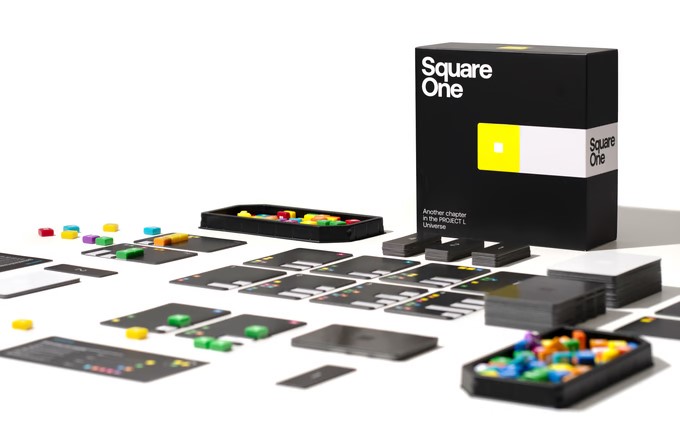
Rather than completing recessed puzzles, you’re trying to complete sequences of tile placements on cards. Once all sequences on a card are finished, you take back your pieces and collect your reward!
The Take, Place, and Master actions return, along with Merge and Split actions that work exactly the way they sound to help you get the pieces you need. You’re also rewarded for completing multiple sequences with a Master action, so timing is key!
The Joker expansion adds wild pieces that can substitute for any piece, as well as 3-reward and 4-point sequences (the base game appears to cap at 2 and 34, respectively). It also allows expansion of gameplay to 5 and 6 players.
Is Project L A Good Game?
I know a lot of seasoned board gamers turn up their nose at this game, but I personally don’t understand why. No, it isn’t the heaviest, most mechanically dense gaming experience out there, and if that’s what you’re looking for, Project L isn’t for you.
But a lot of us don’t want that in a board game. Many of us want a game that is minimally luck dependent, has a lot of strategic depth, is easy to bring our friends in to play, and feels fresh from game to game.
And Project L checks every single one of those boxes.
I’d recommend this in a heartbeat for any board game group that likes the “easy to learn, difficult to master” genre of games, those who want something with a manageable, but deep pool of strategic depth, and families who are looking for a cool game to introduce their littles to when they’re ready for something a little more challenging.
So thanks for the recommendation Phil – I look forward to breaking this out a ton in the game nights to come.
Other Board Game Articles You’ll Love:
- Project L 2 Player Gameplay
- How To Play Scotland Yard
- Axe-A-Lot-L Strategy Guide
- Tiny Epic Galaxies Rules PDF
- CuBirds Game Review
- Cindr Board Game Gameplay
Braden is a founder of Assorted Meeples and has been a gamer & writer with a vivid imagination all his life. Don’t believe us? Check out his excitement when meeting Goosebumps author R.L. Stine as a kid! An avid Magic: The Gathering spellslinger for over 15 years, you can always convince him to shuffle up for a game (or three!) of Commander.
